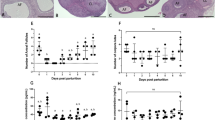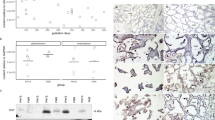Abstract
MOST macropodid marsupials conceive at postpartum oestrus and the 100-cell embryo enters into and remains in embryonic diapause while there is a suckling young in the pouch1. Removal of the pouch young results in reactivation of the quiescent corpus luteum and of the diapausing blastocyst. Prolactin inhibits corpus luteum development tonically during lactational quiescence in the tammar wallaby, Macropus eugenii2. However, it is not known whether the hormonal milieu associated with lactation, or the neural stimulus of suckling itself is the primary signal to the hypothalamus which results in the maintenance of embryonic diapause in M. eugenii. I therefore examined the role of the neural pathway from the mammary gland in tammar wallabies carrying diapausing embryos. I report here that after denervation of the suckled mammary gland, the quiescent corpus luteum and the diapausing blastocyst resumed development, whereas none of a sham-operated group initiated blastocyst development. The pouch young grew at a normal rate and continued to obtain milk from denervated glands, despite the presence of a developing embryo in the uterus.
This is a preview of subscription content, access via your institution
Access options
Subscribe to this journal
Receive 51 print issues and online access
$199.00 per year
only $3.90 per issue
Buy this article
- Purchase on Springer Link
- Instant access to full article PDF
Prices may be subject to local taxes which are calculated during checkout
Similar content being viewed by others
References
Tyndale-Biscoe, C. H., Hearn, J. P. & Renfree, M. B. J. Endocr., 63, 589–614 (1974).
Tyndale-Biscoe, C. H. & Hawkins, J. in Reproduction and Evolution (eds Calaby, J. H., Tyndale-Biscoe, C. H.) 245–252 (Australian Academy of Science, 1977).
Griffiths, M., McIntosh, D. L. & Leckie, R. M. C. J. Zool. Res. 166, 265–275 (1972).
Renfree, M. B., Green, S. W. & Young, I. R. J. Reprod. Fert, (submitted).
Renfree, M. B. & Tyndale-Biscoe, C. H. Devl Biol. 32, 28–40 (1973).
Murphy, C. R. & Smith, J. R. Trans. R. Soc. S. Aust. 94, 15–20 (1970).
Denamur, R. & Martinet, J. C.r. hebd. Séanc. Soc. Biol. 148, 833–836 (1954).
Linzell, J. L. Q. Jl exp. Physiol. 48, 34–60 (1963).
Cross, B. A. Symp. Zool. Soc. Lond. 41, 193–210 (1977).
Hearn, J. P. Nature 241, 207–208 (1973).
Tyndale-Biscoe, C. H. Ciba Fan Symp. (in the press).
Short, R. V. Ciba Fdn Symp. 45, 73–86 (1973).
Hearn, J. P., Short, R. V. & Baird, D. T. in Reproduction and Evolution (eds Calaby, J. H. & Tyndale-Biscoe, C. H. 255–263 (Australian Academy of Science, 1977).
Author information
Authors and Affiliations
Rights and permissions
About this article
Cite this article
RENFREE, M. Initiation of development of diapausing embryo by mammary denervation during lactation in a marsupial. Nature 278, 549–551 (1979). https://doi.org/10.1038/278549a0
Received:
Accepted:
Published:
Issue Date:
DOI: https://doi.org/10.1038/278549a0
This article is cited by
Comments
By submitting a comment you agree to abide by our Terms and Community Guidelines. If you find something abusive or that does not comply with our terms or guidelines please flag it as inappropriate.



